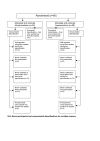Buprenorphine versus dihydrocodeine for opiate detoxification in primary care: a randomised controlled trial
- PMID: 17210079
- PMCID: PMC1774569
- DOI: 10.1186/1471-2296-8-3
Buprenorphine versus dihydrocodeine for opiate detoxification in primary care: a randomised controlled trial
Abstract
Background: Many drug users present to primary care requesting detoxification from illicit opiates. There are a number of detoxification agents but no recommended drug of choice. The purpose of this study is to compare buprenorphine with dihydrocodeine for detoxification from illicit opiates in primary care.
Methods: Open label randomised controlled trial in NHS Primary Care (General Practices), Leeds, UK. Sixty consenting adults using illicit opiates received either daily sublingual buprenorphine or daily oral dihydrocodeine. Reducing regimens for both interventions were at the discretion of prescribing doctor within a standard regimen of not more than 15 days. Primary outcome was abstinence from illicit opiates at final prescription as indicated by a urine sample. Secondary outcomes during detoxification period and at three and six months post detoxification were recorded.
Results: Only 23% completed the prescribed course of detoxification medication and gave a urine sample on collection of their final prescription. Risk of non-completion of detoxification was reduced if allocated buprenorphine (68% vs 88%, RR 0.58 CI 0.35-0.96, p = 0.065). A higher proportion of people allocated to buprenorphine provided a clean urine sample compared with those who received dihydrocodeine (21% vs 3%, RR 2.06 CI 1.33-3.21, p = 0.028). People allocated to buprenorphine had fewer visits to professional carers during detoxification and more were abstinent at three months (10 vs 4, RR 1.55 CI 0.96-2.52) and six months post detoxification (7 vs 3, RR 1.45 CI 0.84-2.49).
Conclusion: Informative randomised trials evaluating routine care within the primary care setting are possible amongst drug using populations. This small study generates unique data on commonly used treatment regimens.
Similar articles
-
The Leeds Evaluation of Efficacy of Detoxification Study (LEEDS) prisons project: a randomised controlled trial comparing dihydrocodeine and buprenorphine for opiate detoxification.Subst Abuse Treat Prev Policy. 2009 Feb 5;4:1. doi: 10.1186/1747-597X-4-1. Subst Abuse Treat Prev Policy. 2009. PMID: 19196468 Free PMC article. Clinical Trial.
-
The Leeds Evaluation of Efficacy of Detoxification Study (LEEDS) project: an open-label pragmatic randomised control trial comparing the efficacy of differing therapeutic agents for primary care detoxification from either street heroin or methadone [ISRCTN07752728].BMC Fam Pract. 2004 Apr 29;5:9. doi: 10.1186/1471-2296-5-9. BMC Fam Pract. 2004. PMID: 15117415 Free PMC article. Clinical Trial.
-
Dihydrocodeine for detoxification and maintenance treatment in individuals with opiate use disorders.Cochrane Database Syst Rev. 2020 Feb 18;2(2):CD012254. doi: 10.1002/14651858.CD012254.pub2. Cochrane Database Syst Rev. 2020. PMID: 32068247 Free PMC article.
-
Comparison of methadone and buprenorphine for opiate detoxification (LEEDS trial): a randomised controlled trial.Br J Gen Pract. 2011 Dec;61(593):e772-80. doi: 10.3399/bjgp11X613106. Br J Gen Pract. 2011. PMID: 22137413 Free PMC article. Clinical Trial.
-
Detoxification From Alcohol and Other Drugs.Rockville (MD): Substance Abuse and Mental Health Services Administration (US); 1995. Report No.: (SMA) 95-3046. Rockville (MD): Substance Abuse and Mental Health Services Administration (US); 1995. Report No.: (SMA) 95-3046. PMID: 22514824 Free Books & Documents. Review.
Cited by
-
Cochrane Schizophrenia Group.Schizophr Bull. 2008 Mar;34(2):259-65. doi: 10.1093/schbul/sbm167. Epub 2008 Jan 31. Schizophr Bull. 2008. PMID: 18245059 Free PMC article. Review. No abstract available.
-
Buprenorphine for managing opioid withdrawal.Cochrane Database Syst Rev. 2017 Feb 21;2(2):CD002025. doi: 10.1002/14651858.CD002025.pub5. Cochrane Database Syst Rev. 2017. PMID: 28220474 Free PMC article.
-
Deaths of opiate/opioid misusers involving dihydrocodeine, UK, 1997-2007.Br J Clin Pharmacol. 2011 Aug;72(2):330-7. doi: 10.1111/j.1365-2125.2011.03908.x. Br J Clin Pharmacol. 2011. PMID: 21235617 Free PMC article.
-
Improving the reporting of pragmatic trials: an extension of the CONSORT statement.BMJ. 2008 Nov 11;337:a2390. doi: 10.1136/bmj.a2390. BMJ. 2008. PMID: 19001484 Free PMC article.
-
The association between outpatient buprenorphine detoxification duration and clinical treatment outcomes: a review.Drug Alcohol Depend. 2011 Dec 1;119(1-2):1-9. doi: 10.1016/j.drugalcdep.2011.05.033. Epub 2011 Jul 8. Drug Alcohol Depend. 2011. PMID: 21741781 Free PMC article. Review.
References
-
- National Treatment Agency . Models of Care: for Adult Drug Misusers. Department of Health, London; 2002.
-
- Drug Misuse and Dependence – Guidelines on Clinical Management. The Stationary Office, London; 1999. Department of Health, Scottish Office Department of Health, Welsh Office, & Department of Health and Social Services, N. I.
-
- Lowinson J, Berle B, Langrod J. "Detoxification of long-term methadone patients: problems and prospects". International Journal of the Addictions. 1976;11:1009–1018. - PubMed
Publication types
MeSH terms
Substances
LinkOut - more resources
Full Text Sources
Medical


